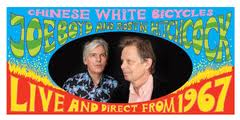Rock and Roll History is built on some interesting musical pillars and I met another one yesterday. Chuck Leavell was here during cherry blossom season to talk about his new book, The Rolling Stones, the blues and to tickle the ivories at the National Press Club for a handful of reporters.
Leavell, in a grey suit and black sweater, sporting curly white hair and trim white beard, seemed to be a figure more from an Atlanta country club than the world of rock bands. Perhaps that’s because between sessions and tours, he’s a gentleman tree farmer in Georgia, an environmental advocate, author and entrepreneur--as comfortable with Mick Jagger as with Sen. John Kerry.
He began by describing how he got started in music--listening to his mother play piano and noodling around on his own until at age seven he announced to his mother: “I want to be a musician when I grow up!” Her response: “Now honey, you know you can’t do both.”
Inspired by Ray Charles and the sounds of Memphis soul, he made his way to Macon, Georgia and Capricorn Records, landing a job in the re-invented Allman Brothers Band in time to record Brothers & Sisters. Next it was his own group, Sea Level for five years and a lot of time as a studio musician. (His current work is with Martina McBride and John Mayer.)
In the early 1980s, he got the call from The Stones and has been touring with them ever since, often serving as “music director” to set up playlists with Mick. He can be heard on Steel Wheels, Voodoo Lounge, Stripped and most other recent Stones' CD's.
Leavell seems almost as passionate about the environment as he is about music. Growing a Better America is his third book about conservation and sustainable growth. He was on the board of the American Forest Foundation for six years and is co-founder of the eco web site Mother Nature Network (www. MNN.com) which, he proudly noted, has just passed the EPA web site in terms of hits.
He insists he is not anti-growth but says, “The choice is between rapid, rampant and reckless or smart, strong and sustainable…something that is possible only if we all choose to do it.”
Here are some other tidbits on the environment.
On the loss of farm and forest land: "Across the United States we are losing more than 2500 acres of land a day to development…and half is covered in impervious surfaces."
On the value of inventing cellulosic fuels: “If we could make that kudzu into basic fuels, we could save the world."
On global warming: “By 2030 there will be no glaciers left in Glacier National Park.”
Here are some music notes.
His new CD, Back To The Woods, a tribute to pioneering blues piano players, is almost finished (Keith Richards plays on How Long That Evening Train Been Gone) and is set for release in August.
Next year marks the 50th year of the Rolling Stones and while he does not know if there will be a new tour, “I certainly hope so, I am ready when they are.”
On Keith’s autobiography: “I loved it, read every page. I was there and even I learned some things!”
With that he sat down at the piano and ripped off a rendition of Down The Road that seemed to channel a little Jerry Lee Lewis.











